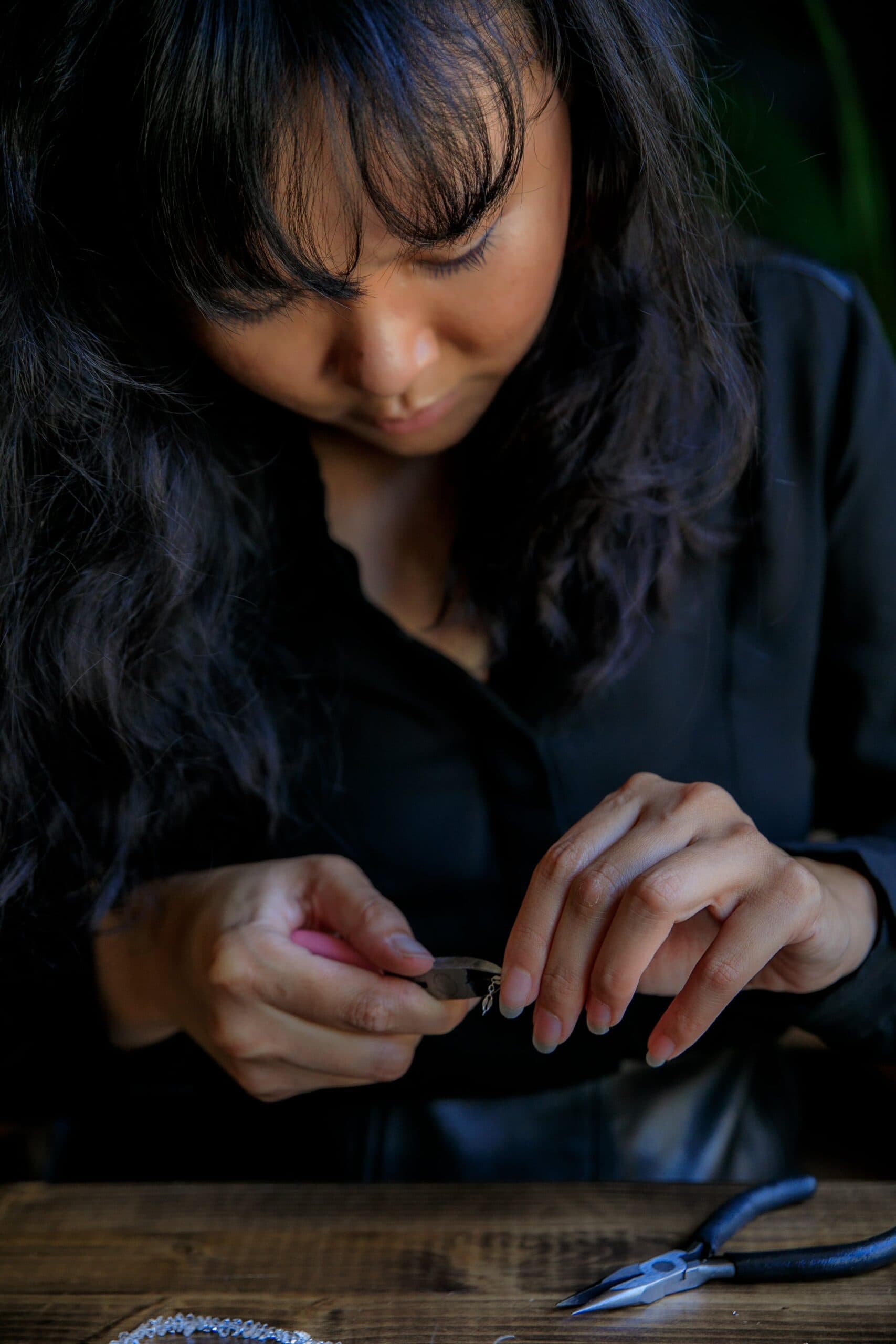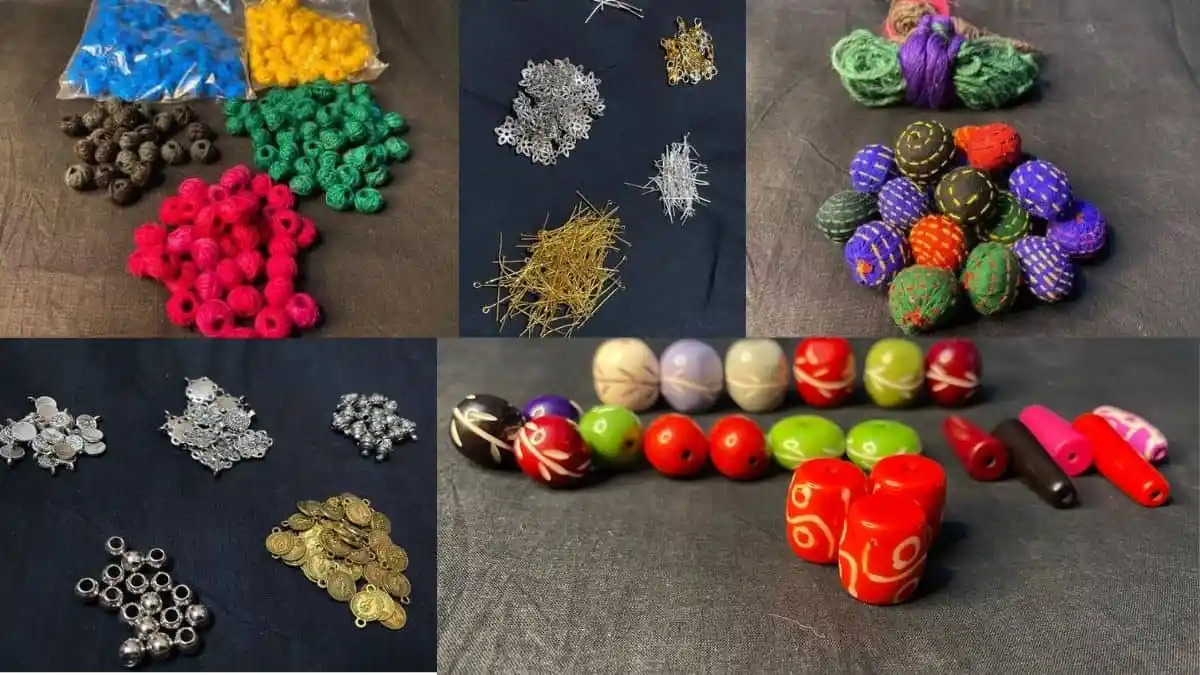Jewelry has been an integral part of human culture for centuries. From ancient civilizations to modern times, jewelry serves as a form of self-expression, a symbol of status, and a way to enhance one’s beauty. While the design and craftsmanship play a crucial role in creating stunning pieces, the choice of materials is equally significant. In this blog, we will explore the world of jewellery making materials, from traditional metals to unique gemstones and alternative materials.
Jewellery Making Materials
Jewellery making is an art form that has been practiced for centuries. One of the most critical aspects of jewelry design and creation is the selection of metals. Metals not only contribute to the aesthetic appeal of a piece but also determine its durability, workability, and value. The most commonly used metals in jewellery making materials are gold, silver, platinum, and palladium, along with base metals like copper, brass, and bronze.
Gold
Gold is the most popular metal used in jewelry due to its lustrous finish and malleability. It is measured in karats (K), with 24K gold being the purest form. However, because pure gold is too soft for everyday wear, it is often alloyed with other metals such as copper, silver, zinc, or nickel to enhance its strength. The addition of these metals can also alter the color of gold, leading to various hues like white, rose, and yellow gold.
Gold is the most in demand precious metals in the world. It always rank among the most expensive precious metals. Many Jewellery designs for wedding or any rituals in South East Asia and Middle East has Gold in it.
Silver
Silver is another precious metal highly favored in the jewelry industry. It is more abundant and less expensive than gold, making it accessible for a broader range of consumers. Sterling silver, an alloy containing 92.5% silver and 7.5% other metals (usually copper), is the standard for jewellery making. It strikes a balance between malleability and durability. Silver can tarnish over time when exposed to air and sulfur-containing substances, requiring regular maintenance to retain its shine.
Platinum
Platinum stands out for its rarity, density, and natural white sheen that does not fade or tarnish. It is more durable than gold and silver, making it an excellent choice for securing gemstones in fine jewelry. Platinum’s density makes it a heavier metal; thus, a platinum piece will feel more substantial than the same piece made of gold or silver. It is hypoallergenic, making it suitable for people with sensitive skin.
Palladium
Palladium is a member of the platinum group metals and shares many of its characteristics but is generally less dense and consequently lighter. It has a natural white color similar to platinum but at a lower price point. Palladium is also hypoallergenic and resistant to tarnishing, making it an appealing alternative to platinum.
Copper
Copper is one of the oldest metals used in jewellery making materials. It boasts a distinct reddish-orange color and is known for its thermal and electrical conductivity. Copper is often used in its pure form but can also be alloyed with zinc to make brass or with tin to make bronze. While copper itself is quite malleable, these alloys are harder and more suitable for intricate work.
Brass
Brass is an alloy of copper and zinc and has a bright, gold-like appearance. Its affordability makes it a popular choice for costume jewelry and larger statement pieces. Brass can vary in color depending on the proportion of copper and zinc; more copper results in a redder tone, while more zinc creates a lighter shade.
Bronze
Bronze is primarily an alloy of copper and tin. It has a warm brown or golden color and has been used in jewelry since antiquity. Its strength and durability make it suitable for both cast jewelry and larger sculptural items. Like brass, bronze can also patina over time, adding character to the jewelry piece.
When working with these metals, jewelers consider several factors such as melting points, malleability, ductility (the ability to be drawn into wire), and color when designing their pieces. Each metal requires different techniques for shaping, joining (such as soldering or welding), and finishing (like polishing or texturing).
In addition to their physical properties, cultural and economic factors also play a role in the choice of metal. Gold and silver have long been associated with wealth and status, while platinum’s rarity often makes it a symbol of exclusivity. Meanwhile, base metals like copper, brass, and bronze are more associated with artisanal or bohemian styles.
Sterling Silver
Sterling silver is an alloy of silver and other metals, usually copper. It is more durable than pure silver and commonly used in everyday jewelry.
Gemstones
Gemstones add color, brilliance, and character to jewelry pieces. They come in various shapes, sizes, and colors. Here are some popular gemstones used in jewellery making:
Diamonds
Known as the “king of gemstones,” diamonds are prized for their brilliance and durability. They are the hardest natural substance on Earth and symbolize eternal love and luxury.
Rubies
Rubies are known for their vibrant red color and are considered one of the most valuable gemstones. They represent passion, power, and protection.
Sapphires
Sapphires come in various colors, but the most well-known is the deep blue variety. They symbolize wisdom, loyalty, and nobility.
Emeralds
Emeralds are prized for their rich green color and are associated with rebirth and love. They are often used in high-end jewelry pieces.
Pearls
Pearls are unique gemstones formed inside mollusks. They are known for their lustrous appearance and have been treasured for centuries. Pearls symbolize purity, elegance, and femininity.
Alternative Jewellery Making Materials
Alternative jewelry-making materials offer a refreshing divergence from traditional metals and gemstones, encouraging both artisans and wearers to embrace innovation, sustainability, and personal expression. These unconventional resources can be derived from various origins including natural elements, industrial products, and recycled goods, each bringing unique textures, colors, and stories to the art of adornment.
Wood
One increasingly popular category of alternative materials is organic substances. Wood, for example, provides a warm and earthy aesthetic that can be carved, shaped, or inlaid with other materials. Bamboo is another sustainable choice, recognized for its lightweight properties and distinctive grain patterns. Seeds, nuts, and beans are also being incorporated into jewelry designs, often reflecting the cultural heritage of the artisan. Tagua nut, also known as vegetable ivory, offers a durable and eco-friendly substitute for animal ivory.
Scraps
In the realm of upcycled materials, the imaginative reuse of everyday objects transforms the mundane into the extraordinary. Scraps from industries like skateboarding or surfboard manufacturing yield colorful layers of repurposed wood and fiberglass, while bicycle inner tubes and tires become durable, rubbery components for modern accessories. Even electronic waste is finding a new life in jewelry; circuit boards with their intricate patterns serve as a high-tech backdrop for futuristic fashion statements.
Natural Fibers
Natural fibers such as silk, hemp, and cotton can be braided, knotted, or woven to create textural pieces that are both lightweight and versatile. With the resurgence of macramé and fiber arts, these materials are enjoying a renewed popularity in the form of tassels, cords, and intricate web-like structures. Similarly, felted wool offers a soft and malleable medium that can be shaped into organic forms or combined with other elements for a mixed-media effect.
In the domain of synthetic alternatives, acrylics and resins are like chameleons in the jewelry world. They can be cast into virtually any shape and tinted with an array of pigments to mimic precious stones or encapsulate objects like flowers, fabric, or even metal shavings. Silicone, commonly used in wearable technology, is also being explored for its hypoallergenic properties and smooth finish.
Glass
Glass is another versatile medium that straddles the line between traditional and alternative. Beyond its use in delicate beads or cut gemstones, glass can be fused, blown, or molded into contemporary designs that play with light and color. Recycled glass from bottles or windows also contributes to sustainable practices within jewellery making.
For those who seek a connection to the past, vintage materials offer a sense of history and nostalgia. You can encase pieces of old lace, antique buttons, or snippets of handwritten letters in metal or resin. This is to create sentimental pieces that tell a story. Found objects like coins, keys, or watch parts are often used in steampunk-inspired creations, where they blend Victorian elegance with industrial edge.
Resin
Resin jewelry allows for endless creativity. It can be molded into various shapes and colors, making it a popular choice for statement pieces.
Leather
Leather jewelry appeals to those who prefer a rugged and edgy style. The bracelets made with Leather, necklaces, and earrings add a touch of individuality to any ensemble.
Wire
Wire jewelry involves bending and shaping wire into intricate designs. It offers flexibility and allows for endless possibilities in creating unique pieces.
Conclusion
Jewellery making materials play a vital role in the creation of stunning pieces. Whether it’s the choice of metals like gold, silver, or platinum, the selection of gemstones like diamonds, rubies, or emeralds, or the exploration of alternative materials like wood or resin, each material contributes to the overall beauty and uniqueness of a piece of jewelry. Aspiring jewelry makers can experiment with different materials to unleash their creativity and create one-of-a-kind designs that reflect their personal style. So go ahead, explore the world of jewellery making materials, and let your imagination run wild!






